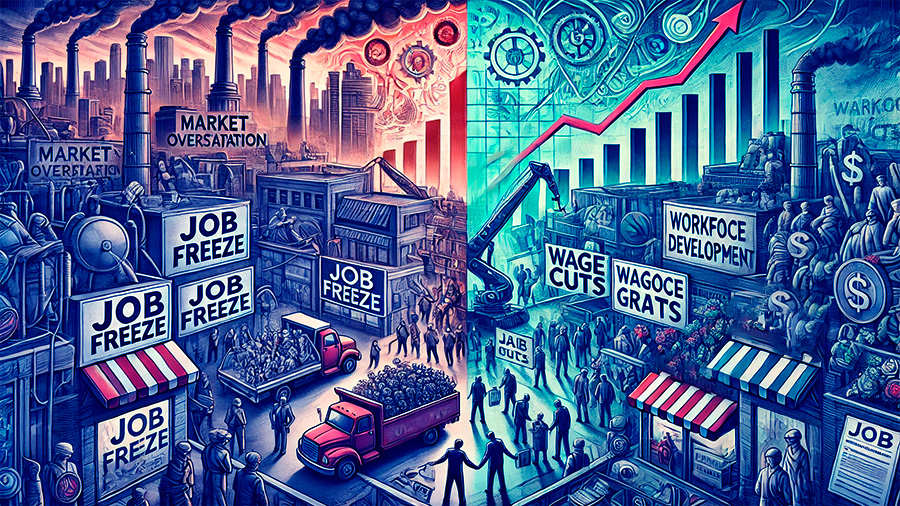The services sector has become a crucial component of modern economies, with industries like healthcare, finance, education, and entertainment driving significant economic activity. However, as demand stabilizes and competition intensifies, many service markets are experiencing oversaturation—an economic condition where the supply of services exceeds the demand. This oversupply can lead to numerous challenges, such as decreased profitability, higher competition, and diminished service quality. In this article, we will explore the concept of market oversaturation in the services sector, how it impacts economic stability and growth, and what businesses and governments can do to mitigate its negative effects.
What is Market Oversaturation?
Market oversaturation occurs when the supply of goods or services exceeds the demand within a given market. In the context of the services sector, oversaturation means that too many companies or service providers are competing for a limited customer base. As a result, service providers are forced to lower their prices or offer additional perks to attract customers, often leading to reduced profit margins and increased competition.
1. Causes of Market Oversaturation in Services
Several factors contribute to market oversaturation, including changes in consumer behavior, technological advancements, and market entry barriers that allow too many businesses to enter a particular sector.
Key causes of oversaturation in the services sector:
- Technological advancements: The advent of new technologies has lowered entry barriers, enabling new businesses to easily enter competitive service markets. For example, the rise of online platforms in industries like education and finance has led to a flood of new service providers.
- Changing consumer preferences: In some markets, changing consumer needs or expectations lead to an overabundance of service options. For instance, the growth of subscription-based services in entertainment has increased the number of options available to consumers.
- Low market barriers: Many services require minimal capital investment to enter, particularly in the digital or tech sectors. This low barrier to entry encourages an influx of new competitors, which can quickly lead to oversaturation.

Impact of Market Oversaturation on Economic Stability
Market oversaturation can have far-reaching effects on economic stability, particularly in sectors that rely heavily on consumer spending and service-based revenue models. When too many businesses vie for a limited pool of consumers, it can trigger several economic consequences that reverberate throughout the economy.
1. Increased Competition and Lower Profit Margins
As the number of service providers increases in an oversaturated market, the competition becomes more intense. Service providers may be forced to lower prices, offer discounts, or increase their marketing expenditures to stand out. This, in turn, can erode profit margins and make it difficult for businesses to remain financially viable, particularly for smaller or new entrants.
Consequences of increased competition:
- Price wars: Service providers may engage in price wars to attract customers, further reducing profitability and leading to unsustainable business practices.
- Decreased service quality: To remain competitive on price, businesses might reduce service quality, which can negatively impact consumer satisfaction and loyalty.
- Business closures: Smaller companies, unable to compete with larger, more established businesses, may be forced to close, leading to job losses and reduced economic activity in the sector.
2. Decreased Innovation and Market Stagnation
In an oversaturated market, service providers may focus more on competing with one another on price rather than investing in innovation or improving their services. This focus on short-term profitability can result in a stagnation of creativity and an overall decline in the quality and diversity of services offered to consumers.
How market stagnation affects the economy:
- Reduced investment in R&D: When businesses are focused on survival rather than growth, they may cut back on research and development (R&D), which can limit technological advancements and innovation in the sector.
- Lower consumer choice: As competition forces companies to cut costs and standardize offerings, consumers may face fewer choices, stifling market variety and progress.
- Slower economic growth: The lack of innovation can also hinder broader economic growth, as the services sector is a major driver of employment, investment, and productivity.

Effects on Employment and Job Market Stability
Market oversaturation can also have significant consequences for employment, especially in sectors with high competition and low margins. As businesses struggle to maintain profitability, they may resort to cost-cutting measures, such as layoffs or reducing employee benefits.
1. Job Losses and Unstable Employment
In an oversaturated market, businesses may be forced to reduce their workforce or freeze hiring in order to manage increasing competition and declining profit margins. This can lead to higher unemployment rates, job insecurity, and a decrease in overall job market stability.
Impact of oversaturation on employment:
- Layoffs: Companies may reduce staff numbers to lower operational costs, particularly in industries like retail, hospitality, and transportation, where competition is fierce.
- Lower wages: With too many businesses competing for the same pool of workers, wages may stagnate or even decrease, making it harder for workers to find stable and well-paying jobs.
- Increased part-time and gig work: As full-time positions become scarce, more individuals may turn to part-time or gig work, which often lacks the stability and benefits of traditional employment.
Mitigating the Effects of Market Oversaturation
To address the challenges of market oversaturation, both businesses and governments need to take proactive measures. By fostering a more balanced and innovative services market, it is possible to mitigate the negative economic consequences of oversaturation.
1. Encouraging Innovation and Differentiation
To stay competitive in an oversaturated market, businesses must focus on differentiation and innovation. Companies should invest in creating unique value propositions, improving customer experience, and leveraging new technologies to offer services that stand out from the competition.
Innovation strategies for businesses:
- Technology adoption: Investing in new technologies such as artificial intelligence, machine learning, or automation can help service providers offer better, faster, and more personalized services.
- Customer-centric solutions: Businesses should focus on providing tailored services that address the unique needs of specific customer segments, rather than offering generic, one-size-fits-all solutions.
- Value-added services: Companies can enhance their offerings by adding complementary services or creating bundled packages that attract customers looking for more comprehensive solutions.
2. Government Intervention and Regulation
Governments can play a critical role in addressing market oversaturation by implementing policies that promote sustainable competition, encourage innovation, and ensure fair market conditions. For example, governments can introduce regulations to prevent monopolistic practices, provide subsidies or tax incentives for innovative businesses, and support industry consolidation when necessary.
Government strategies to manage oversaturation:
- Regulating market entry: Governments can introduce measures to control the influx of new businesses into oversaturated markets, ensuring that businesses entering the market are well-prepared to succeed.
- Supporting R&D: By offering tax breaks or grants for research and development, governments can encourage businesses to innovate and improve the quality of their services, rather than merely competing on price.
- Market consolidation: In certain cases, governments can encourage consolidation in oversaturated industries through mergers and acquisitions, creating more viable and competitive companies.
Conclusion
Market oversaturation in the services sector presents significant challenges to businesses, employees, and overall economic stability. However, through a combination of innovation, strategic differentiation, and government policies, it is possible to overcome these challenges and maintain a balanced, thriving market. By focusing on improving service quality, encouraging technological advancements, and ensuring that the job market remains stable, businesses and governments can mitigate the negative effects of oversaturation and pave the way for long-term growth and sustainability.


